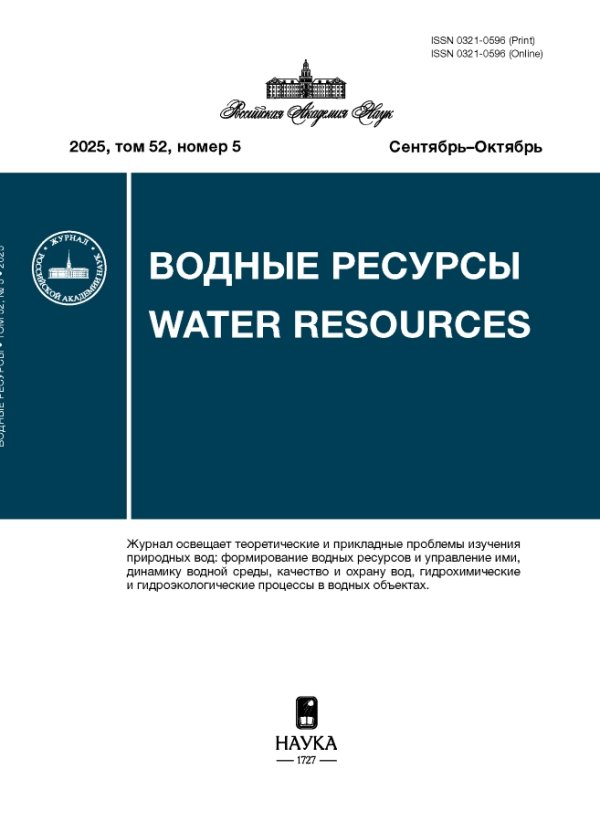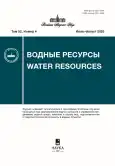Оценка содержания крупных коллоидов методом динамического рассеивания света при химическом анализе речных вод Дальнего Востока РФ
- Авторы: Шулькин В.М.1, Еловский Е.В.2
-
Учреждения:
- Тихоокеанский институт географии ДВО РАН
- Дальневосточный геологический институт ДВО РАН
- Выпуск: Том 52, № 4 (2025)
- Страницы: 78-93
- Раздел: ГИДРОХИМИЯ, ГИДРОБИОЛОГИЯ, ЭКОЛОГИЧЕСКИЕ АСПЕКТЫ
- URL: https://journal-vniispk.ru/0321-0596/article/view/320053
- DOI: https://doi.org/10.31857/S0321059625040065
- ID: 320053
Цитировать
Аннотация
Об авторах
В. М. Шулькин
Тихоокеанский институт географии ДВО РАН
Email: shulkin@tigdvo.ru
Владивосток, 690041 Россия
Е. В. Еловский
Дальневосточный геологический институт ДВО РАНВладивосток, 690022 Россия
Список литературы
- Гордеев В.В., Лисицын А.П.Геохимическое взаимодействие пресноводной и морской гидросфер // Геология и геофизика. 2014. Т. 55. № 5–6. С. 721–744.
- Михайлик Т.А., Тищенко П.Я., Колтунов А.М., Тищенко П.П., Швецова М.Г.Влияние реки Раздольной на экологическое состояниевод Амурского залива (Японское море) // Вод. ресурсы. 2011. Т. 38. № 4. С. 474–484.
- РД 52.24.353-2012 Отбор проб поверхностных вод суши и очищенных сточных вод. М.: Росгидромет, ГХИ, 2012. 35 с
- Чудаева В.А.Миграция химических элементов в водах Дальнего Востока. Владивосток: Дальнаука, 2002. 391 с.
- Шестеркин В.П.Изменение химического состава вод Амура в период исторического наводнения в 2013 году // Вод. ресурсы. 2016. Т. 43. № 3. С. 287–296.
- Шулькин В.М., Богданова Н.Н., Еловский Е.В.Влияние кольматирования фильтров на определение концентрации истинно-растворенных и коллоидных форм миграции химических элементов в речных водах // Вод. ресурсы. 2022. Т. 49. № 1. С. 91–102. doi: 10.31857/S0321059622010163
- Anderson W., Kozak D., Coleman V.A., Jamting A.K., Trau M.A comparative study of submicron particle sizing platforms: Accuracy, precision and resolution analysis of polydisperse particle size distributions // J. of Colloid and Interface Sci. 2013. 405. P. 322–330.
- Cuss C.W., Donner M.W., Grant-Weaver I., Noernberg T., Pelletier R., Sinnatamby R.N., Shotyk W.Measuring the distribution of trace elements amongst dissolved colloidal species as a fingerprint for the contribution of tributaries to large boreal rivers // Sci. Total Environ. 2018. V. 642. P. 1242–1251.
- Filella M., Zhang J., Newman M.E., Buffle J.Analytical applications of photon correlation spectroscopy for size distribution measurements of natural colloidal suspensions: capabilities and limitations // Colloids Surfaces A: Physiсochem. Eng. Aspects. 1997. V. 120. P. 27–46.
- Filippov S.K., Khusnutdinov R., Murmiliuk A., Inam W., Zakharova L.Ya., Zhang H., Khutoryanskiy V.V.Dynamic light scattering and transmission electron microscopy in drug delivery: a roadmap for correct characterization of nanoparticles and interpretation of results // Mater. Horiz. 2023. 10. P. 5354–5370.
- Gaillardet J., Viers J., Dupre B.Trace elements in river waters. Surface and groundwater, weathering and soils. In:Treatise on geochemistry/ EdsH.D. Holland, K.K. Turekian. Oxford, UK: Elsevier-Pergamon, 2003. V. 5.Р. 225–272.
- Hirst C., Andersson P.S., Shaw S., Burke I.T., Kutscher L., Murphy M.J., Maximov T., Pokrovsky O.S., Morth M., Porcelli D.Characterization of Fe-bearing particles and colloids in the Lena River basin, NE Russia // Geochim. Cosmochim. Acta. 2017. 213. P. 553–573.
- Horowitz A.J., Lum K.R., Garbarino J.R., Hall G.E.M., Lemieux C., Demas C.R.Problems associated with using filtration to define dissolved trace element concentrations in natural water samples // Environ. Sci.Technol. 1996. V. 30. 954.
- Ilina S.M., Lapitsky S.A., Alekhin Y.V., Viers J., Benedetti M., Pokrovsky O.S.Speciation, size fractionation and transport of trace element in the continuum soil water–mire– lake– river–large oligotrophic lake of a subarctic watershed // Aquat. Geochem. 2016. 22 (1). P. 65–95.
- Ingri J., Widerlund A., Land M., Gustafsson O., Andersson P., Ohlander B.Temporal variations in the fractionation of the rare earth elements in a boreal river; the role of colloidal particles // Chem. Geol. 2000. 166. P. 23–45.
- Krickov I., Pokrovsky O.S., Manasypov R., Lim A., Shirokova L.S., Viers J.Colloidal transport of carbon and metals by western Siberian rivers during different seasons across a permafrost gradient // Geochim. Cosmochim. Acta.2019. 265. P. 221–241.
- Langevina D., Raspauda E., Mariota S.Towards reproducible measurement of nanoparticle size using dynamic light scattering: Important controls and considerations //NanoImpact. 2018. V. 10. P. 161–167.
- Morrison M., Benoit G.Filtration artifacts caused by overloading membrane filters // Environ. Sci. Technol. 2001. V. 35. P. 3774−3779.
- Pokrovsky O.S., Viers J., Shirokova L.S., Shevchenko V.P., Filipov A.S., Dupre B.Dissolved, suspended, and colloidal fluxes of organic carbon, major and trace elements in the Severnaya Dvina River and its tributary // Chem. Geol. 2010. 273. P. 136–149.
- Pokrovsky O.S., Manasypov R.M., Loiko S.V., Shirokova L.S.Organic and organo-mineral colloids in discontinuous permafrost zone // Geochim. Cosmochim. Acta. 2016. V. 188. P. 1–20.
- Pokrovsky O.S., Schott J.Iron colloids/organic matter associated transport of major and trace elements in small boreal rivers and their estuaries (NW Russia) // Chem. Geol. 2002. V. 190. P. 141–179.
- Shiller A.M.Syringe filtration methods for examining dissolved and colloidal trace element distributions in remote field locations // Environ. Sci. Technol. 2003. V. 37. P. 3953–3957.
- Shulkin V.M.The Use of Centrifugation for the Separation of Suspended and Colloidal Forms of Chemical Elements in the Analysis of River Waters: Possibilities and Limitations // Water Resour. 2024. V. 51. № 4. P. 550–561. doi: 10.1134/S0097807824700945
- Vasyukova E.V., Pokrovsky O.S., Viers J., Oliva P., Dupre B., Martin F., Candaudap F.Trace elements in organic and iron-rich surficial fluids of the boreal zone: Assessing colloidal forms via dialysis and ultrafiltration // Geochim. Cosmochim. Acta. 2010. 74. P. 449–468.
- Wilde F.D., Radtke D.B., Gibs Jacob, Iwatsubo R.T. Processing of water samples (ver. 2.2): U.S. Geological Survey Techniques of Water-Resources Investigations, 2004 with updates through 2009. Book 9. Chap. A5.http://pubs.water.usgs.gov/twri9A5(accessed: April 17, 2024)
Дополнительные файлы










